

Flowers of East Nepal
| Last year I visited Tibet and central Nepal to watch blue poppies, and
this year I went trekking to the rain kingdom, East Nepal to look for another
poppy. East Nepal is only about 200 km across Sikkim from the world's heaviest
rainfall area - Meghalaya Province of India, and it rains 12,000 mm (12
meters) annually. There is a burst of rainfalls when the moisture of the
monsoon, which is coming up from the Bengal Bay along the Brahmaputra River,
hits the mountain clump of Kanchanjunga (8,586 m), the third highest peak
in the world. And it causes cliff collapses, floods and destructions everywhere.
Meanwhile, I have taken two trekkings of Topke Gola - Jargare Himal and Kanchanjunga Circuit based on Taplejung in Northeast Nepal from the latter half of June to the end of July. The latter route is the path that a Japanese botanist Nakao Sasuke walked about 60 years ago. Here I introduce the flowers that are blooming in the smoking rain and sometimes shining in the morning sun in a dark rhododendron forest.
Three days after I left, my father who had been bedridden passed away as if he was going to see his son who took the flowers in the sky. He lived the era of Taisho, Showa, Heisei which were turbulent time, and quietly closed his 95 years old life. Since I was out of wired/wireless area it was after the funeral that I got in touch with the news. While I met him before departure and said good-bye, it became a regretful parting. So I send his this flower as my sincere condolence. |
||||
| ITINERARY (1) Topke Gola - Jaljale Himal Trek
(2) Kangchenjunga Circuit (Tseram – Ghunsa) Trek
(3) Gosainkunda (for Acclamation)
|
||||||||||||||||||||||||||||||||||||||||||||||||||||||||||||||||||||||||||||||||||||||||||||||||
  (from Google map) (1)Flowers in Topke Gola = Jaljale Himal Trek We planned to go to Papung with 4 WD, but we did not find a rent-a-jeep due to monsoon season, so we had to walk along the river (Mewa Khola). The altitude there is 650 m and subtropical sun shines are glitering. From the Papung leaches are emerging from the dark and wet forest. We spent 4 days to reach Topke Gola instead of planned 2 days. |
||||||||||||||||||||||||||||||||||||||||||||||||||||||||||||||||||||||||||||||||||||||||||||||||
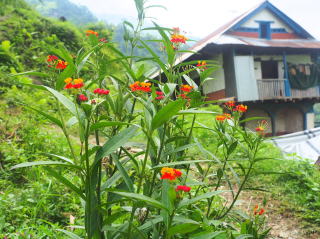 |
Asclepias curassavica This flower native to South America blooms from late autumn to early winter in Japan, but in Nepal it blooms in summer. If the flowering factor is not sunshine or temperature, what is the cause of flowering? Did it lose the sense of season due to coming to the northern hemisphere? The back is a local house in tin roofing. (alt. 700 m) |
|||
|
In Nepal, rice planting season starts from the end of June. When the seedlings grow, and the rice fields are filled with water, rice planting starts in a week. All family members are coming to the field and planting. In Japan we were doing the same way 60 years ago. The rice field borders are made by heaping up a lot of stones, which has been built for hundreds of years. I camped the day before in front of the blue roof house visible in the upper central of the picture. (alt. 800 m) |
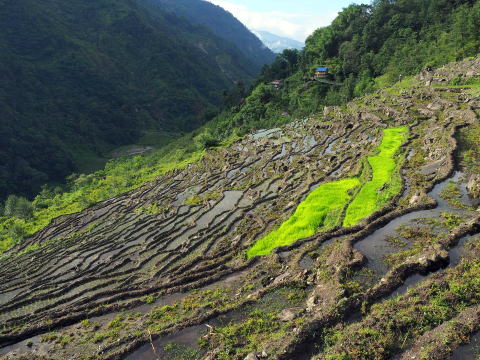 |
|||
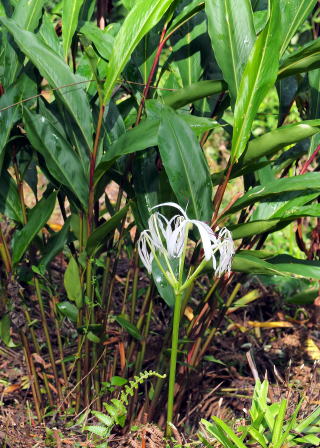
|
Cardamom (Elettaria cardamomum) A ginger company, take spices from the seeds for curry materials. It is indispensable for seasoning Nepal 's national meal dālbhāt. Villagers are cultivating cardamom along the a stream, and making it a source of cash income. (Cardamom field)
|
|||
| When going past Papung, we finally entered the forest zone. Under dim forest, flowers which like moisture shined mysteriously. | |
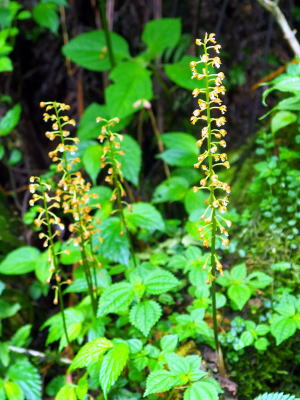 |
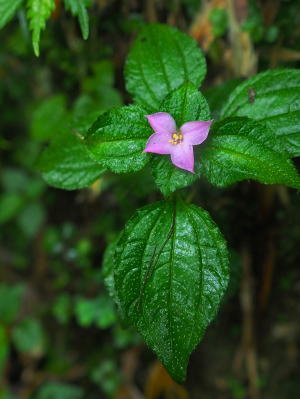 |
| Calanthe family | Melastome family |
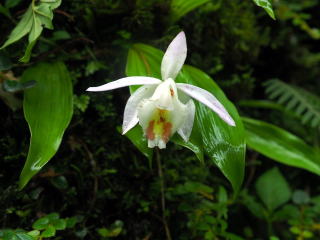 |
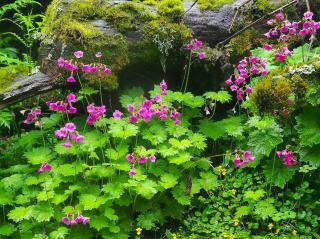 |
| Pleione hookeriana | Primula geranifolina |
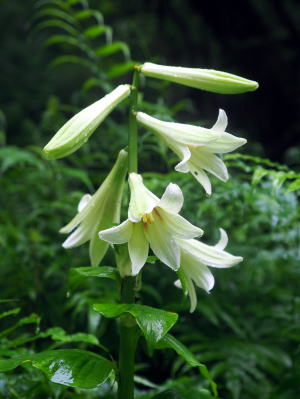 |
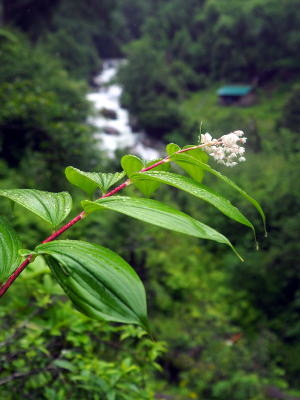 |
| Cardiocrinam giganteum | Maianthemum purpureum |
According to the itinerary prepared by the travel agency, travel between Tuplejung and Papung was supposed to arrive in one day by taking a jeep, and that between Papung and Topke Gola was a day's walk. However, when we arrived, there was no jeep due to monsoon, so we had to walk for 2 days on the river bank under the scorching sun. Also distance between Papung to Topkögola is 16 km and altitude difference is 1900 m, which a porter who is supposed to have fast legs cannot walk in a day. We were forced to camp in roadside where leeches were attacking us badly. This sloppy plan caused serious problems later, but that story came later. And it took 4 days to arrive at Topke Gola (altitude 3,700 m). But, there was a reward. |
|
.jpg) 1.jpg) |
|
| Meconopsis walliichii (South of Topke Gola, alt. 3400 m) There is a small Khalka (pasture land) about 3 km to Topke Gola. There flowers with wine color, or reddish-purple and little blue color. It was Meconopsis (blue poppy companion). To see this flower was one of my purposes of this trekking this time. The length is about 160 cm and the diameter of flower is about 15 cm to 20 cm. This flower was named after Nathaniel Wallich (1786 –1854) who was the second director of the Kolkata Botanic Garden. He took a blue poppy in Nepal and sent the specimen to Europe, introducing the blue poppy for the first time to the academic world. You
can see pale yellow flowers in the picture on the above. It looks like Meconopsis
paniculata, but it is still M. walliichii. The way to distinguish is whether
the leaf slices reach to the main vein of the leaf. The picture below is M. paniculata
that grew nearby. Try to compare the shapes of the leaves. |
|
|
Topke Gola, A Village of Flowers There
are 13 households at the same height as Mt. Fuji, where they are living by yak grazing.
Also they are engaged in transportation business with yak as a main vehicle. (At the entrance of village in full bloom of yellow flowers such as buttercup) |
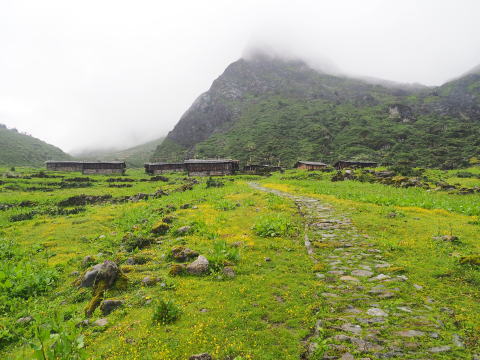 |
| (Around Sado Pokhari – alt. 3800 m) | (At the Kharka on the way to Pansang Pass – alt. 4200 m) |
1.jpg) |
2.jpg) |
(Under the Rhododendron forest – alt. 3850 m) |
|
1.jpg) |
2.jpg) |
Comparing
M. Grandis in grassland and that of forest, the latter has a large flower
(diameter 25 cm) and a length of about 2 m, and the leaves have less bristles
and are smooth. I do not know if the reason is coming from simply nutrition or
variation. If it is classified as a variant species in the future, I prepare a
variation name for that time as |
|
Since our schedule was tight, we shortened our two days plan for searching flowers and resting in Topke Gola in one day and crossed 5012 m high pass to head for Thudam with dragged heavy legs. |
|
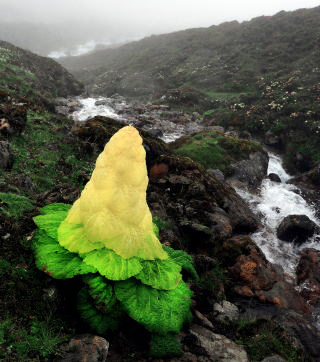
|
Rheum nobile Annual grasses of Rhubarb genus of Polygonace family. It is also called Tall Rhubarb. It likes humidity, and grows on the south side of the pass where the fog of monsoon hits directly here, so you cannot see them on the northern side as the wind gets moist off past the pass. There are some ruins that have been eaten and scattered here and there, local people are eating flower buds which are packed by the bract. It tastes sour, just like sorrel. (On the south slope of Pansang Banyang, atl 5012m) |
|
Pansang Banyang Pass (alt. 5012 m) A simple pass with merely one cairn (Cholten) where only local people are
crossing over. The white road with granite stone that a glacier has grinded
down for a long time conjures bone
road. Beyond the pass we went down to the bottom of the glacial valley and on the steep slope. There were pale yellow flowers on a wall of the end moraine (a trace of glacier). |
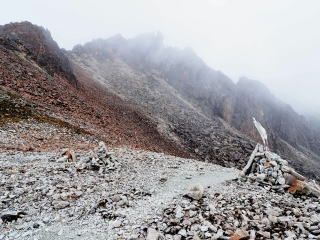 |
|
|||||||
| When going down to the glacier valley deeper, there were also blue poppies
here – Meconopsis grandis.
When we arrived at the riverside camp and reconsidered the process from now on, we realized that it was impossible to go on schedule because the plan was too loose I decided not to go further because I missed the return flight and the flowers in bloom in other places if went on. I took a rest for a day there, crossed the pass again, and arrived at to Topke Gora then took the way to Jaljale Himal. We marched from Topke Gora to the west along the river and stayed at Doupi Khalka for 2 nights, where I explored flowers along the Saju Khola. M. paniculata and M. grandis welcomed me.
|
|||||||
| Unfortunately I could not find Blue's Meconopsis walliichii which I looked for but instead... |
|||||||
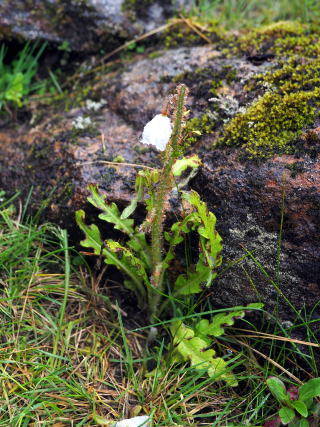 |
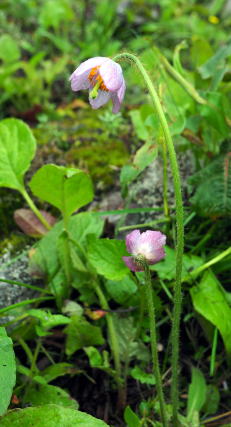 |
||
|
Meconopsis sinuata |
Meconopsis
simplicifolia The length of the stem with flower is about 20 cm, but when the flower becomes to fruit it extends more than double. |
||
| Other than blue poppies.... | |||
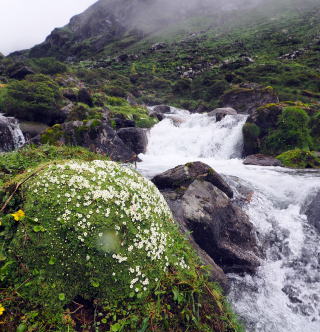 |
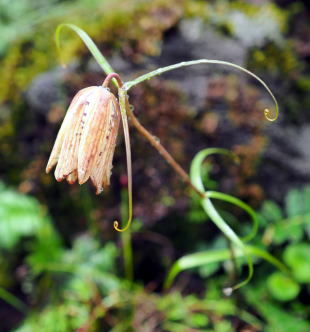 |
||
| Arenaria sp. | Fritillaria cirrhosa | ||
Trekking course of Jaljale Himal goes around rocky mountains and ponds (pokhari) with repeating ascent and descent between 4000 m to 4500 m. In the morning (until around 10 o'clock) weather is nice and pleasant, but it is always rainy in the afternoon. Porters hate rain so that they hurry to the next camp site, which makes me left alone behind of them. |
|||
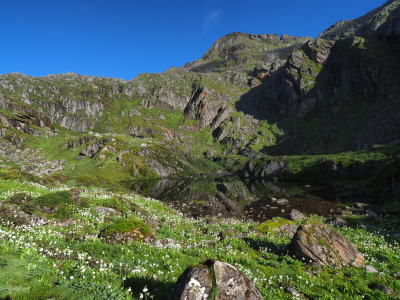 |
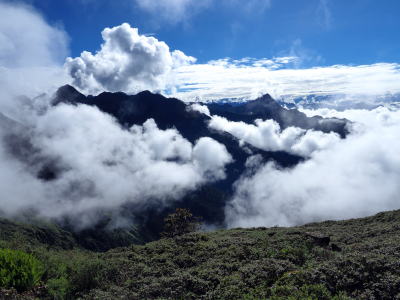 |
| Camp site at Jamle pokhari (alt. 4200 m) | Going on the ridge route. Raining under the clouds. |
|
||||||
The day before the final day of the trekking we headed to the village Sang at the foot from Giddhe Danda. As usual the slowest porter departed first, followed by me, a guide, a porter carrying my loads, then followed by young healthy porters who put away our tent. When arriving at the destination this order was reversed, and young porters were setting tents there. However, on this day, as the guide hurried the way back, he had not lose his way. We noticed his mistake and returned to the original road after 1 hour. For this reason, the caravan was divided. The sun had already sunk and the forest was wrapped with dense darkness. My GPS was the sole reliance source and it worked, so we could reach the lodge at around 10 pm. Three porters were left behind in the forest and they spent the night in the dark forest. Disaster in Mt. Tomuraushi crossed my head. Fortunately, on the next day three of them arrived safely, but if it happened the worst my trekking might have ended there. |
(2)Flowers around Kangchenjunga Trek
| The eastern end of Nepal, where borders to Sikkim, is the frontier of Nepal and is quite related to Japan. In 1912, Buddhist Bunkyo Aoki had entered this area from Sikkim to who smuggle himself in Tibet. And the Kyoto University mountaineering club (AACK) was founded in 1931 with the aim of climbing Mt. Kabru (7338m), south of Kanchenjunga. (Although the plan was not realized due to the WWII, the team had first climbed Mt. Yalun Kang (8, 505 m) in May 1973) Then, in 1962 Sasuke Nakao who headed the Osaka Prefecture Univ. mountaineering club for climbing Mt Nuptu (6044 m), stood on Nango La (4776 m) in the south, and marked that blue poppies (Meconopsis Grandis) were in full bloom and left pictures. ("Himalaya's Flower" (Mainichi Shimbun)) It is almost sixty years since my predecessors and seniors walked. I tried walking along the path of their dreams. |
When heading for Kangchenjunga, Nepali people were in the boiling water at the football world cup games. They decorated the national flag of their supporting team and raised a banner to expressing their wishes. Football fever of Nepalese people is considerable. |
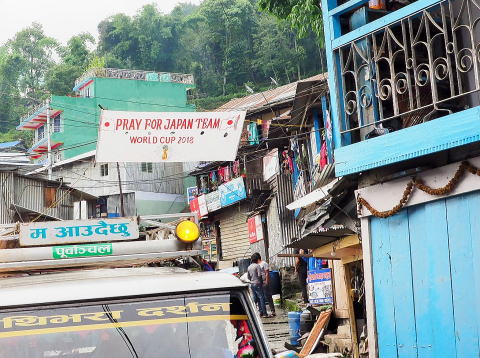 |
←A banner to support Japanese team (at Taplejung) A jeep driver patronizes French team 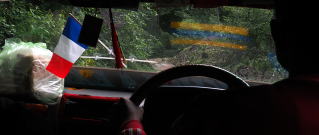 |
This route is a part of Great Himalaya trekking course across Nepal from the east to the west, but the start point is at the small stream with altitude of 1,500 m, and goes through the farmhouse's garden, along the paddy field, and inside the corn field. And that is also in the kingdom of LEECHES. |
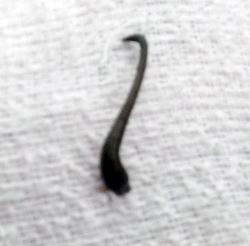 Leech on a towel |
Leech The movement for search for blood of the prey with shaking its head looks somewhat yacky-pretty. But if it comes to its size becoming 5 ~ 10 cm, it is truly amazing! Once sucked on, it won’t leave for a long time. If you try to forcibly get away, the chewing mouth remains on your skin and make it tickled later. When it finishes to suck blood, it falls without any itching, but blood will not stop for about 2 hours, and the surroundings will be dyed red. In this trekking I have donated a lot of blood. The measure is an Air Salonpas (muscle pain relief air sole). Blown away. It falls off instantly and there remains no bite marks. |
The roads where leeches appear are wet and the flowers that like humidity are advantageous. |
|
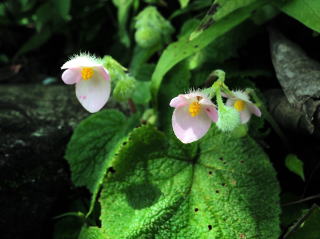 |
.jpg) |
|
| Begonia picta |
Chirita sp. |
|
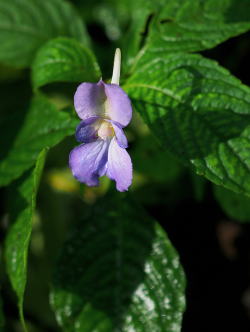 |
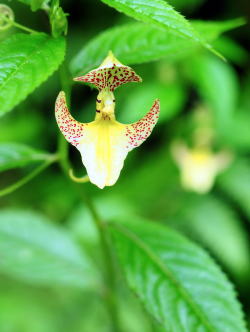 |
|
| Impatiens family | Impatiens falcifer | |
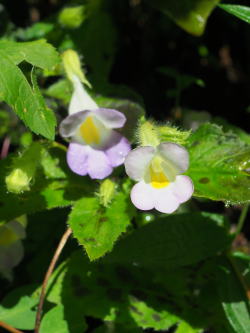 |
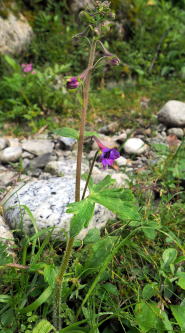 |
|
| Chirita bifolia | Delphynium drepanocentrum | |
| Ascending to the Lashiya Pass at 3400 m high, we descended to the bottom
of the river flowing out of the Yalun Glacier and went upstream of this river. When
exceeded 3300 m red wine colored Meconopsis began to appear. |
Meconopsis walliichii var.
fusco-purpurea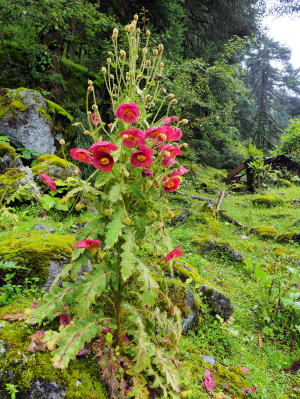 |
This is a variant of Meconopsis walliichii seen in Topke Gola. It is higher
in length and more flowers than M. walliichii there..jpg) |
|
| (Between Tortong and Tseram alt. 4050 m ~ 4100 m) | The diameter of the flower is 10 cm, the length is 140 - 160 cm (some closes to 2 m) |
Tseram is a small village with only 4, 5 farmers grazing yaks. The
central square of the village is the place where the yaks rest from the
pasture, and also used for camp site. For this reason, there are a lot of dunks
around the tents. You should be careful and watch your step when you go to toilet
at night.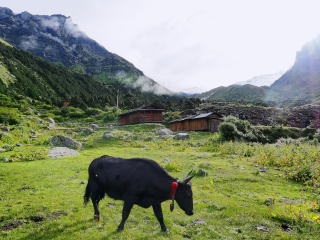 |
| We went upward along the side moraine of the Yalun Glacier. On the way, I found a colony of M. grandis and M. paniculata, which remained after blooming on the side of a stream along moraine. A couple of weeks earlier you would have watched superb color patern of yellow and blue. |
.jpg) |
Since side moraine of Yalun Glacier is about 20 m in height, you cannot
see the inside of glaciers without climbing. At Oxtang, when looked down the inside…
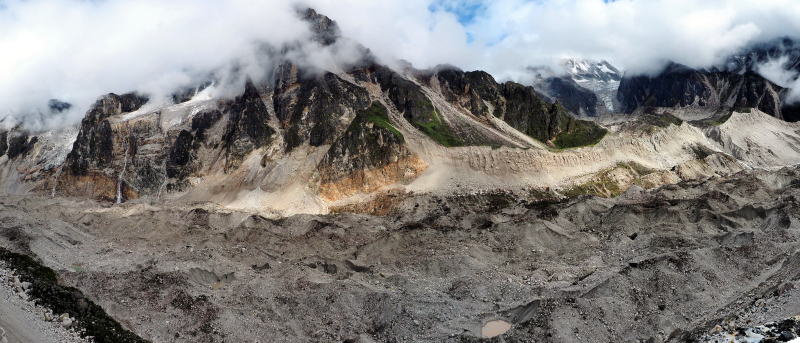 |
|||
Is a glacier white ? Certainly the glaciers in Switzerland and Alaska
are white, but here it is scraping down the mountains and rolling up the soil
and sand. It is a desolate world like after the flood. The glacier flows from
left to right, but it is too slow to see it is flowing. Nevertheless, there are
roaring sound of the rock falls sometimes. (The black peak is the front peak of
Rotong (6682 m), a part of Kotang (6148 m) can be seen across the suspended
glacier on the right)
|
|||
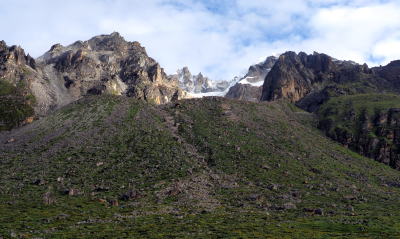 |
The next day, I explored the end moraine of a small glacier on the west side of the Yalun Glacier. I traversed the middle of the end moraine from left to right. On the top of the end moraine there is a small glacial lake in which upper glaciers are flowing down. |
Flowers during the Exploration
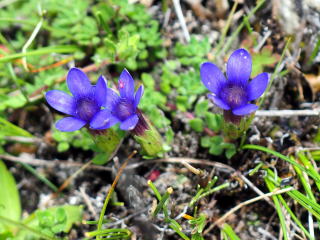 |
Gentian family Look
like Gentiana jamesii in Hokkaido. |
|
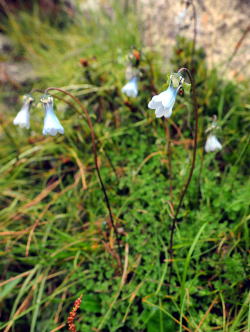 |
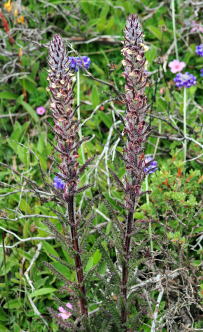 |
|
| Codonopsis thalictrifolia | Pedicularis klarkei | |
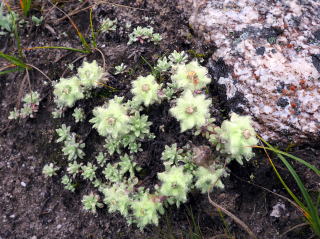 |
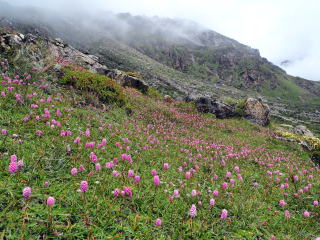 |
|
| Leontopodium monocephalum | Bistorta sherei | |
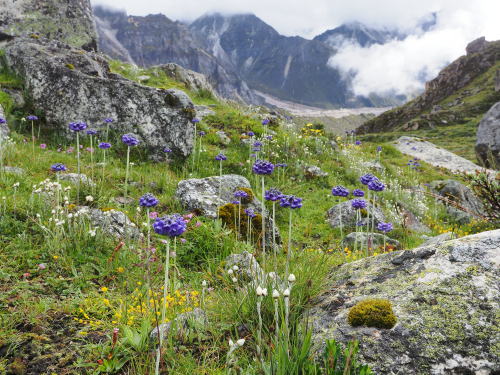 |
Primula capitata subsp. crispata Blue bonbon candies are standing around the side moraine. They are the main characters of this valley along with Bistorta and Anafalis. Cow and yak (and its mix) come from this hill foot (Ramche) to this pasture on a day-to-day basis. They never eat this flower because it has poison. Therefore, they are prospering. (South of Oxtang alt. 4650 m, Yalun Glacier is visible in the back) |
| It was hard to find the blue poppy that I expected. It started rain as well. I gave up and tried to get back to the tent. When I went down the end moraine and turn at a rock…. |
|
|
Meconopsis horridula The leaves are bigger than M. horridula in Tibet and Qinghai Province, and the bristles are sparse. It may be less necessary protect itself from drying due to growing in the rain kingdom. I could not find anything else other than this one.The guide tried to cheat me saying "There is no water here, so that camping is impossible". But I refuted him by finding a small stream nearby and forced him to set up my tent. It was worth. (South of Oxtang alt. 4770 m) |
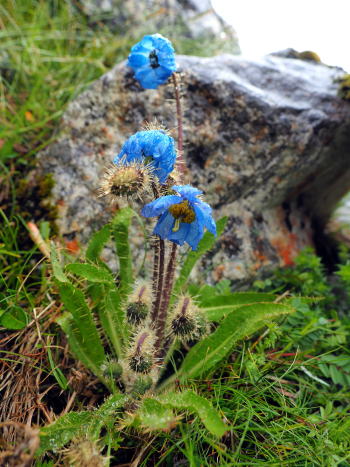 |
|||
| It became fine in the morning when we left Oxtang. I said good-bye to Kabru and Rotang that I saw their whole features for the first time, and returned to Tseram. 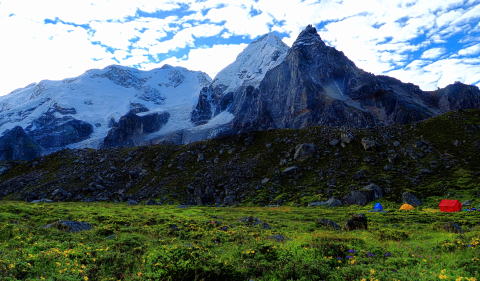 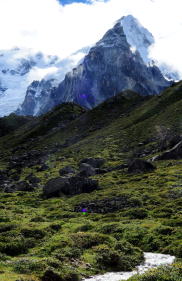 (Left)Mt. Kabru is the gentle mountain on the left (the protrusion peak is Kabru Ⅲ (7338 m)). Its right is Rotong (6682 m). Black peak is the front peak of Rotong.Beyond the ridgeline is India (Sikkim province). (Right) Rotong and its front peak After taking a one day rest in Tseram, we crossed Sinion Pass (4645 m), Milgin Pass (4648 m) then headed for Ghunsa. From Tseram to Ghunsa |
||||
| Meconopsis walliichii var. fusco-purpurea M. walliichii had appeared one after another in the mountain road from Tseram to the pass. The clouds buried Tseram valley but after waiting for a while the clouds flew away and rocky peaks on the other side had appeared. Flowers started shining on the morning sun. It is a good shutter opportunity which never got in the valley bottom. I returned back to the spot where this flower was blooming and pressed the camera shutter. (North of Tseram, alt. 4000 m) |
1.jpg) |
|||
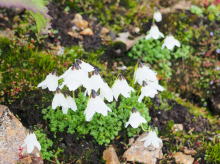 |
← Primula soldanelloides
|
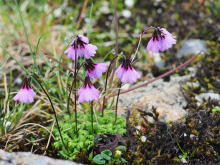 |
||
|
||||
| Ghunsa is the political, economic, cultural and religious center of this region. In addition, trekker lodges are standing like forest trees as it is the starting point (end point) of Kanchenjunga sightseeing. This day I was the only guest staying in this village, but the village would be full of guests in the trekking season from autumn to spring. |
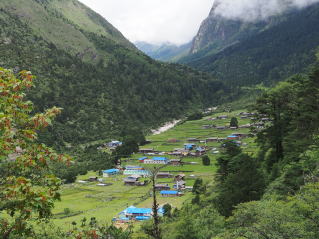
|
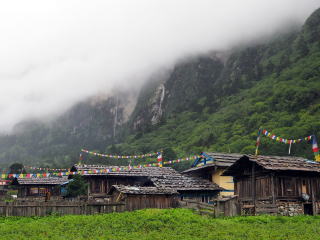 Local houses. Buddhist flags (tarcho) on the roof are flowing with the wind. When the flag flows to the mountain, it comes fine. |
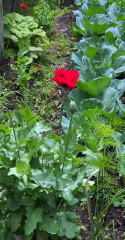 Opium poppy planted at the house garden |
|||||||||||||||||||||
Now I am entering into the final chapter of the trekking. I came here is to see what was seen by Sasuke Nakao who visited Nango La nearly 60 years ago. For this purpose I fought leeches and also the guide. Receiving the morning sunshine on my back, I left for Kalka, base of Nango La. We once descended along Ghunsa Khola down to 3200 m, then climbed again along the valley. The first appearing flowers were lily and campanula which are usually growing in low altitude mountains.
Climbing up to the rock slide area (alt. 3800 m ~ 4000 m) you can look a sea of M. walliichii var. fusco-puruprea. |
|||||||||||||||||||||||
.jpg) (South of Kharka alt. 4000 m) (South of Kharka alt. 4000 m) |
|||||||||||||||||||||||
|
.jpg) |
||||||||||||||||||||||
.jpg) In the forest of M. paniculata there were many M. grandis already finished with flowers. |
|||||||||||||||||||||||
| Prof. Nakao visited here on June 22, 1962. I came on July 28th, a month later, so there was no choice even though I did not see M. grandis. But why did Nakao not mention about M. paniculata and/or M. walliichii were blooming here. I guess some reasons. One is that only M. grandis was blooming when he visited here and no other Meconopsis was not. Certainly M. walliichii blooms late, so it possible that no M. walliichii was here when he came. But what about M. paniculata? When I visited Topke Gola a month ago there blooms both M. grandis and M. paniculata nearby. There was actually no M. paniculata (M. walliichii also) here when he visited 60 years ago and transplanted later? Or did he merely forget to describe about M. paniculata which was existing everywhere because he was too attracted by the charm of blue to see other flowers. My question is getting deeper. Anyway here is a large community of three kinds of blue poppies. In early July, there would be opportunity to see these three flowers at the same time. | |||||||||||||||||||||||
| I climbed 500 m up on a steep gravel trail of the slope to attain Nango La pass. Nakao had crossed over the pass and headed for Mt. Nuptu to climb to its summit, but I had turned back here. |
|||||||||||||||||||||||
|
|||||||||||||||||||||||
| Flowers on the Way Back | ||||
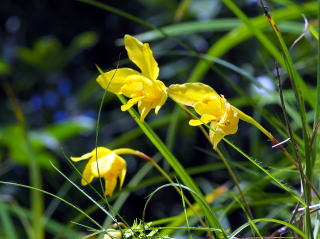 |
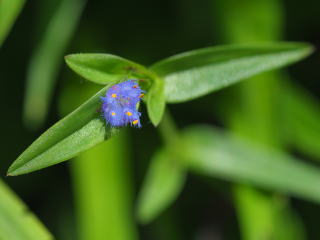 |
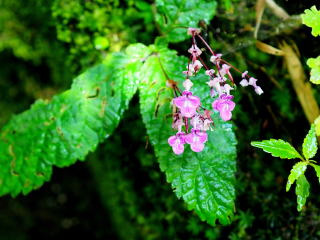 |
||
| Spathoglottis ixioides | Cyanotis cristata | Didymocarpus oblongus | ||
21.jpg) |
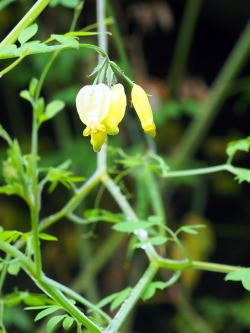 |
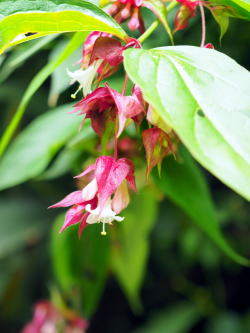 |
||
| Delphinium sp. (D. scabriflorum?) | Decentra macrocapnos | Unknown (Deutzia sp.?) |
(3)Flowers in Gosainkunda
| Gosainkunda trekking is the best and easiest way for acclimatization. You can go to the pond (kunda means pond) in 3 days from Kathmandu. Trekkers I met there were light-worn, so I worried that "When the weather changes, what will they do?" (In such case there are mountain huts every 1 km, so that they may escape in). I intended to find two kinds of blue poppies in this area, but I had to return in one day-stay at the pond due to my heavy high-altitude disease, which once experienced there happens twice. Thanks to that, I had been able to successfully cross over the 5000 m pass afterwards. | ||
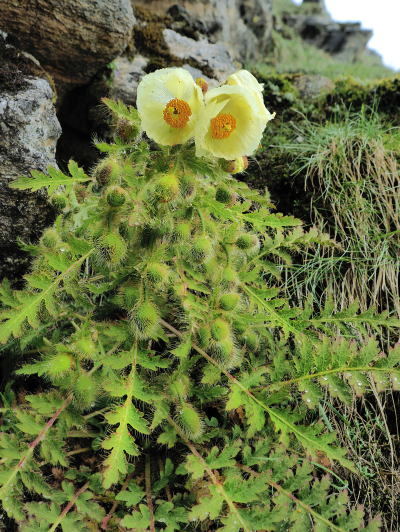 |
Meconopsis napaulensis This flower was the first blue poppy introduced to Europe in 1820 by Nathaniel Wallich of Kolkata Botanical Garden. He collected this flower in Gosainkunda with his employee, so napaulensis means Nepal. At that time, as the Meconopsis cambrica (Welsh poppy) was known in Europe this flower was also classified as Meconopsis as it was the same yellow flower. If (there were no IF in history) a blue color poppy such as M. simplicifolia were introduced for the first time, it might have not classified as Meconopsisi and would have other new genus name. Cambrica is now out of the genus Meconopsis and M. napaulensis became a source of confusion in the nomenclature of Meconopsis. It has a strange fate. (West of Gosainkunda, alt. 4350 m) |
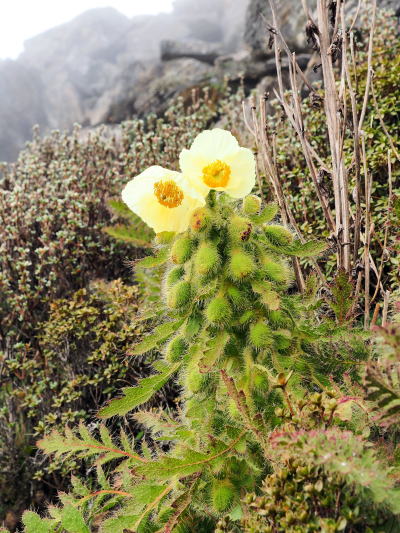 |
| M. walliichii was previously seen to be belonged in M. napaulensis because the leaves are similarly deep cut. However, the fruit attaching style and the length are completely different. I searched for another kind of Meikonopsis, M. dhwoji, but I could not find it. | ||
Other Flowers in Gosainkunda Trek
| Lloydia
tibetica (East of Cholang Pati alt. 3600 m) |
1.jpg) |
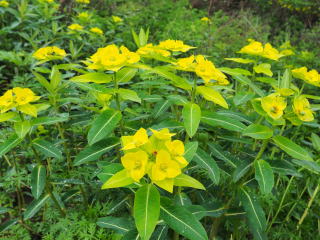 |
Euphorbia
luteoviridis |
| Primula rotundifolia |
1.jpg) |
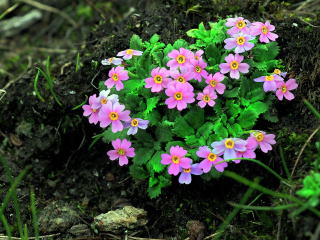 |
|
| Primula concinna? (Both: West of Gosainkunda alt. 4350 m) |
|||
|
Apongiocarpella Purpurea There is a purple form. (East of Lauri Banyang alt. 4100 m) |
1.jpg) |
1.jpg) |
Oxygraphis Endlicheri (East of Lauri Banyang alt. 4100 m) |
Gosainkunda is the holy place of Hinduism. There is a big festival in July, and a lot of pilgrims gather not only from Nepal but also India. Of course, accommodation is lacking, so they sleep with a tent. For this reason, there are many flat places along the trek road so that a tent can be set up. Some of the pilgrims are ascending with the Trident Spear which is the symbol of God Shiva. Pilgrims are piling stones at the side of Gosainkunda on the summit and praying health and happiness for family and own. |
|
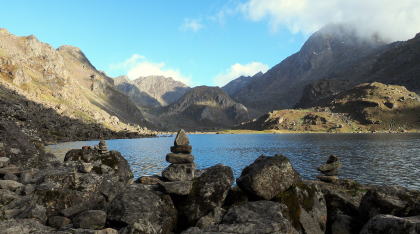 |
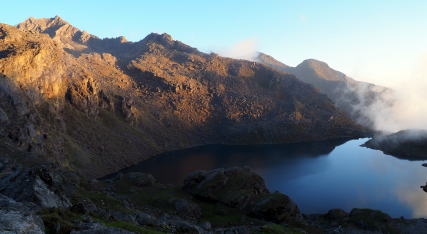 |
| I was also praying that "My father’s death is peaceful and calm” when I had not received the notice of his death. | |
There are a lot of various sized ponds among the rocky mountains in Gosainkunda. I have heard the creation myth of this pond from my guide.
There are mountains exceeding 7000 m such as Langtang Himal and Ganesh Himal around Gosainkunda. As Gosainkunda is a single peak, we have fairly beautiful views of these mountains.
|
2018.10.18 upload